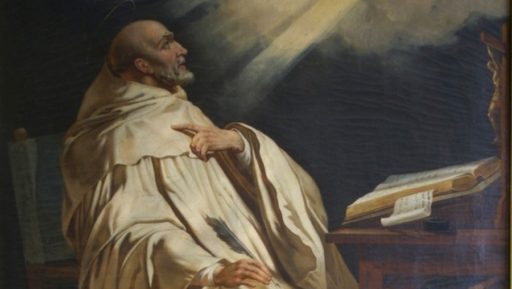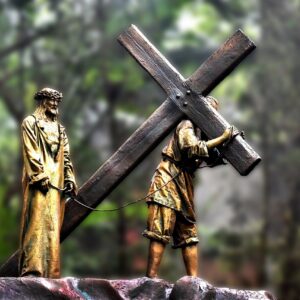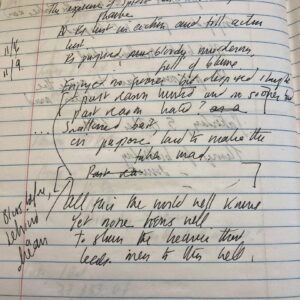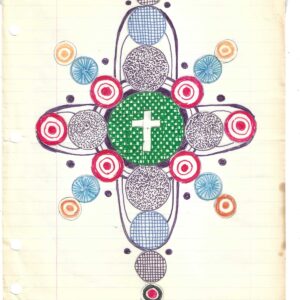I gained new appreciation of that smile after reading Isaac Slater’s recently published Beyond Measure: The Poetics of the Image in Bernard of Clairvaux.
I wouldn’t have known about the book if it hadn’t been for an email my wife Peggy received from the author not long ago. Slater— or more properly Fr. Slater, a Trappist monk who resides at the Abbey of the Genesee just south of Rochester, NY— is a longtime friend of ours, and the Abbey has been and remains a source of hope and inspiration for us on our path to knowing God through contemplative prayer.
But Fr. Slater’s book— which we immediately ordered and I just as immediately read— is precious to me not simply as a good friend’s fine accomplishment. It is, for me, preciously timely. That’s because I had just been puzzling once again why it is that Bernard of Clairvaux plays such a climactic role in the unfolding of Dante’s The Divine Comedy. Fr. Slater’s Beyond Measure answered that question fully— I would even say it answered it “beyond measure”— echoing Jesus’s words in Luke 6:38 for the reward for forgiving others: in another translation, “full measure and flowing over.”
My long-standing puzzlement has had to do with the fact that it is Bernard, not Virgil, not even Beatrice, who is Dante’s final guide and maestro on his long, laborious journey from the pit of Hell to the Empyrean. It is Bernard to whom Beatrice, in Canto XXXII of the Paradiso, entrusts Dante as she returns to her place in the Celestial Rose. Bernard points out to Dante various features of that Rose, and then, at the beginning of the final Canto, XXXIII, Bernard gives on Dante’s behalf an extended prayer to the Virgin Mary, asking her that she so cleanse Dante’s vision that he might achieve his unremitting desire of seeing God as He is— yet not lose his essential humanity in doing so.
Yes, I’ve thought, I see why Dante would choose Bernard to offer such a prayer, given Bernard’s devotion to Mary; for Bernard was, in Dante scholar Fr. James Torrens’s words, “the paradigm for eloquence of his age and [Mary’s] tender-hearted devotee.” But why allow Bernard’s voice to be the last we hear in the entire Comedy? And why, after he concludes his prayer, is Bernard’s final gesture not verbal? Why is it his smile? As Dante writes:
Bernard signed to me with a smile to look upward, but already of myself I was doing what he wished; for my sight, becoming pure, was entering more and more through the beam of the lofty light which in itself is true. (Sinclair translation)
Perhaps it seems that Dante is contradicting himself here. How could he see Bernard’s smile if his eyes were directed elsewhere, to and into the “beam of the lofty light”? The answer is that, immersed in that light after such a long journey out of darkness, Dante sees Bernard as God sees him, and vice versa. The two are joined in a light where seeing and being are one in God— yet both remain distinct within the radiance of God’s love for the entire created world in all its particularity. That Bernard “signed to me with a smile” (m’accennava e sorridea) on Dante’s achieving his goal emphasizes their relative difference in experience and stature— as well as their overarching commonality.
But of what, exactly, did that commonality consist? Their Christian faith, obviously, as well as their profession as writers (Bernard primarily of sermons). But not their countries of origin (Bernard grew up in Burgundy, Dante in Florence), not their times (Bernard antedates Dante by 200 years), not their life choices (Bernard became the Abbot of Clairvaux monastery, Dante a politician and father of a family). By contrast, Dante’s commonalities with Virgil and Beatrice are amply demonstrated within the Divine Comedy itself— Virgil as Dante’s poetic inspiration and guide, Beatrice as his muse and intercessor. But what bound Bernard to Dante closer in some sense even than to these two?
Enter Fr. Slater and Beyond Measure. The book’s subtitle immediately suggested an answer to my question: The Poetics of the Image in Bernard of Clairvaux. “Poetics of the image…” hmm. Let me see. Here in Dante we have image upon image, as well as images interwoven within images, of a journey of faith from the bottom of the created universe all the way up into the highest heaven— a journey recreated in such a way that all who read it can imagine themselves embarked on that same journey despite all differences of language, idiom, cultural reference, even of religious belief or unbelief: an availability to any reader’s imagination made possible by “poetics” of the most original and accomplished sort.
How Dante achieved that goal has long been and continues to be a delight to discuss. My aim here is only to suggest that Dante’s confidence in being able to harness poetry itself to the task of bringing souls closer to God found its most powerful advocate in Bernard, and especially in what, according to Fr. Slater, Bernard has to say about the “poetics of the image.”
Fr. Slater’s use of “poetics” isn’t literal. He’s not talking about prosody or other forms of literary practice. He’s talking, as Bernard does in his sermons, about the physical, emotional, intellectual, and spiritual discipline necessary for those desiring above all things to conform themselves to the “image” of Christ — who is himself the Image of God. But where Christ is the Image in the fullest sense, where image and reality are one, we mortals are in the Image, invited guests of the Image, more or less able to share in Christ’s life.
Clearly the Incarnation is central to Bernard’s “poetics.” God is not remote from us, but a full sharer in our everyday existence. We are constantly invited to move ever closer into the Image — not losing ourselves in the process but becoming more truly who we are, for our reality and our freedom to become who we are (or not) are inextricably entwined.
Fr. Slater puts the matter this way:
Bernard’s view and presentation of the spiritual are highly charged and dynamic: the seeker is always falling back or straining forward to the goal, moving from conformity with Jesus crucified to transformation from glory to glory.… The education of the desire towards the eternal sets love in order and heals inner division. Bernard teaches that in his Ascension Christ elevates and transforms the love of those who look longingly after him as he carries their desire with him into heaven.
What Bernard gave Dante was, I believe, the spiritual grounding for a different “poetics of the image,” but one that was equally “highly charged and dynamic.” And equally dedicated to bringing readers along with him in the image of that Ascension.
But Bernard never lets us forget that even in heaven, even especially there, we are human. Dante never lets us forget it either. Even amidst the splendor of the Empyrean, we catch Bernard’s smile. The true human touch. The humor of it, the fellow-feeling, the admiration, the paternal pride, the joy, the gratitude, the humility, the tact. Full measure and flowing over.
After getting his PhD in English literature, George Dardess taught close reading to his own students until his retirement. Since then he has been ordained a Deacon in the Roman Catholic Church and written several books on Muslim-Christian relations. He has also created the graphic novel Foreign Exchange.





